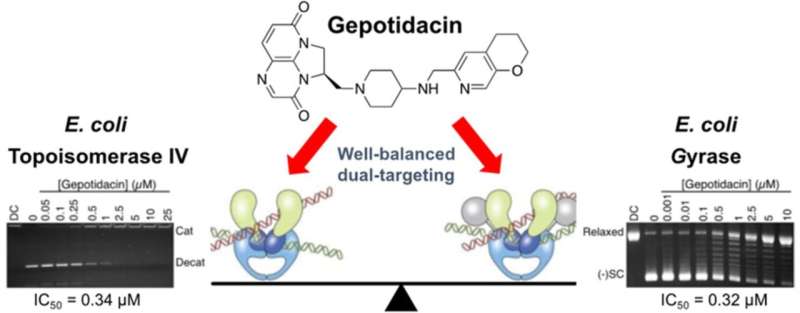This article has been reviewed according to Science X's editorial process and policies. Editors have highlighted the following attributes while ensuring the content's credibility:
fact-checked
peer-reviewed publication
trusted source
proofread
Biochemists discover first new antibacterial class in decades

Vanderbilt biochemists are part of a team taking a stride toward the development of antibacterials to treat uncomplicated urinary tract infections, a pervasive bacterial infection that affects 50%–60% of women in their lifetime.
Led by Neil Osheroff, John Coniglio Chair in Biochemistry and professor of biochemistry and medicine, Vanderbilt researchers are the first to undertake a systematic analysis of the mechanism of action of gepotidacin, a first-in-class triazaacenaphthylene antibacterial, against its targets in Escherichia coli—the type II topoisomerases gyrase and topoisomerase IV—and the mechanistic basis for drug resistance. E. coli is the etiological agent of most urinary tract infections.
The research is published in the journal ACS Infectious Diseases.
"Gepotidacin displayed well-balanced dual targeting of gyrase and topoisomerase IV in E. coli cells, which was reflected in a similar inhibition of the catalytic activities of these enzymes by the compound," Osheroff said. "This finding is critical because it means that to get resistance to geoptidacin, there will have to be simultaneous mutations in two separate enzymes. This makes it much less likely that resistance will develop."
The data from this research, a joint project between the Osheroff laboratory and researchers at the global biopharma company GlaxoSmithKline, are being submitted to the Food and Drug Administration as the "mechanism of action" portion of the application by GSK for the use of gepotidacin to treat urinary tract infections in humans. Gepotidacin is poised to become the first new class of antibacterials to be approved for use in humans in decades.
The work is the second gepotidacin paper recently published by the Osheroff laboratory. Their first research paper on gepotidacin was recently honored by ACS Infectious Diseases as one of the most highly read and cited articles in the first 10 years of the journal.
Outcomes of clinical trials were described in The Lancet, as well as in an accompanying commentary article.
"Overall, the results of the EAGLE-2 and EAGLE-3 trials provide strong evidence that gepotidacin is an effective and safe oral antibiotic for the treatment of uncomplicated urinary tract infections. Gepotidacin has the potential to be a valuable new treatment, which is particularly promising for patients who are resistant to other antibiotics or who are intolerant to first-line treatments.
"Once gepotidacin enters regular clinical use and as real-world evidence emerges, signs of emerging resistance should be closely monitored and health economic analysis should be developed to temper clinical excitement regarding a new antibiotic and to better understand the best use of this new agent in clinical practice," wrote the authors of the commentary.
More information: Alexandria A. Oviatt et al, Interactions between Gepotidacin and Escherichia coli Gyrase and Topoisomerase IV: Genetic and Biochemical Evidence for Well-Balanced Dual-Targeting, ACS Infectious Diseases (2024). DOI: 10.1021/acsinfecdis.3c00346
Journal information: The Lancet , ACS Infectious Diseases
Provided by Vanderbilt University





















